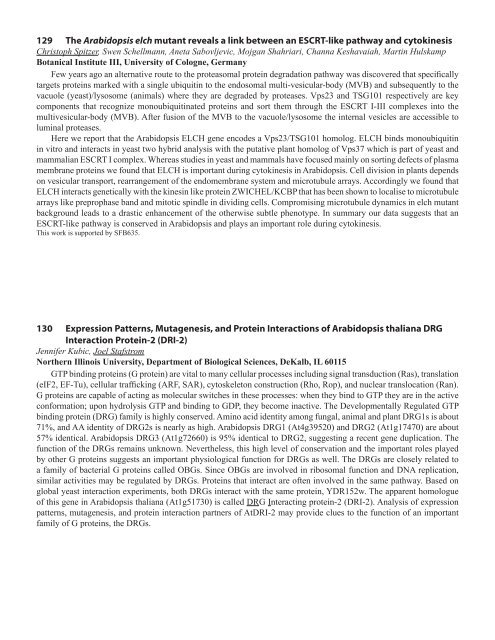75 Integrating Membrane Transport with Male Gametophyte ... - TAIR
75 Integrating Membrane Transport with Male Gametophyte ... - TAIR
75 Integrating Membrane Transport with Male Gametophyte ... - TAIR
You also want an ePaper? Increase the reach of your titles
YUMPU automatically turns print PDFs into web optimized ePapers that Google loves.
129 The Arabidopsis elch mutant reveals a link between an ESCRT-like pathway and cytokinesis<br />
Christoph Spitzer, Swen Schellmann, Aneta Sabovljevic, Mojgan Shahriari, Channa Keshavaiah, Martin Hulskamp<br />
Botanical Institute III, University of Cologne, Germany<br />
Few years ago an alternative route to the proteasomal protein degradation pathway was discovered that specifically<br />
targets proteins marked <strong>with</strong> a single ubiquitin to the endosomal multi-vesicular-body (MVB) and subsequently to the<br />
vacuole (yeast)/lysosome (animals) where they are degraded by proteases. Vps23 and TSG101 respectively are key<br />
components that recognize monoubiquitinated proteins and sort them through the ESCRT I-III complexes into the<br />
multivesicular-body (MVB). After fusion of the MVB to the vacuole/lysosome the internal vesicles are accessible to<br />
luminal proteases.<br />
Here we report that the Arabidopsis ELCH gene encodes a Vps23/TSG101 homolog. ELCH binds monoubiquitin<br />
in vitro and interacts in yeast two hybrid analysis <strong>with</strong> the putative plant homolog of Vps37 which is part of yeast and<br />
mammalian ESCRT I complex. Whereas studies in yeast and mammals have focused mainly on sorting defects of plasma<br />
membrane proteins we found that ELCH is important during cytokinesis in Arabidopsis. Cell division in plants depends<br />
on vesicular transport, rearrangement of the endomembrane system and microtubule arrays. Accordingly we found that<br />
ELCH interacts genetically <strong>with</strong> the kinesin like protein ZWICHEL/KCBP that has been shown to localise to microtubule<br />
arrays like preprophase band and mitotic spindle in dividing cells. Compromising microtubule dynamics in elch mutant<br />
background leads to a drastic enhancement of the otherwise subtle phenotype. In summary our data suggests that an<br />
ESCRT-like pathway is conserved in Arabidopsis and plays an important role during cytokinesis.<br />
This work is supported by SFB635.<br />
130 Expression Patterns, Mutagenesis, and Protein Interactions of Arabidopsis thaliana DRG<br />
Interaction Protein-2 (DRI-2)<br />
Jennifer Kubic, Joel Stafstrom<br />
Northern Illinois University, Department of Biological Sciences, DeKalb, IL 60115<br />
GTP binding proteins (G protein) are vital to many cellular processes including signal transduction (Ras), translation<br />
(eIF2, EF-Tu), cellular trafficking (ARF, SAR), cytoskeleton construction (Rho, Rop), and nuclear translocation (Ran).<br />
G proteins are capable of acting as molecular switches in these processes: when they bind to GTP they are in the active<br />
conformation; upon hydrolysis GTP and binding to GDP, they become inactive. The Developmentally Regulated GTP<br />
binding protein (DRG) family is highly conserved. Amino acid identity among fungal, animal and plant DRG1s is about<br />
71%, and AA identity of DRG2s is nearly as high. Arabidopsis DRG1 (At4g39520) and DRG2 (At1g17470) are about<br />
57% identical. Arabidopsis DRG3 (At1g72660) is 95% identical to DRG2, suggesting a recent gene duplication. The<br />
function of the DRGs remains unknown. Nevertheless, this high level of conservation and the important roles played<br />
by other G proteins suggests an important physiological function for DRGs as well. The DRGs are closely related to<br />
a family of bacterial G proteins called OBGs. Since OBGs are involved in ribosomal function and DNA replication,<br />
similar activities may be regulated by DRGs. Proteins that interact are often involved in the same pathway. Based on<br />
global yeast interaction experiments, both DRGs interact <strong>with</strong> the same protein, YDR152w. The apparent homologue<br />
of this gene in Arabidopsis thaliana (At1g51730) is called DRG Interacting protein-2 (DRI-2). Analysis of expression<br />
patterns, mutagenesis, and protein interaction partners of AtDRI-2 may provide clues to the function of an important<br />
family of G proteins, the DRGs.





